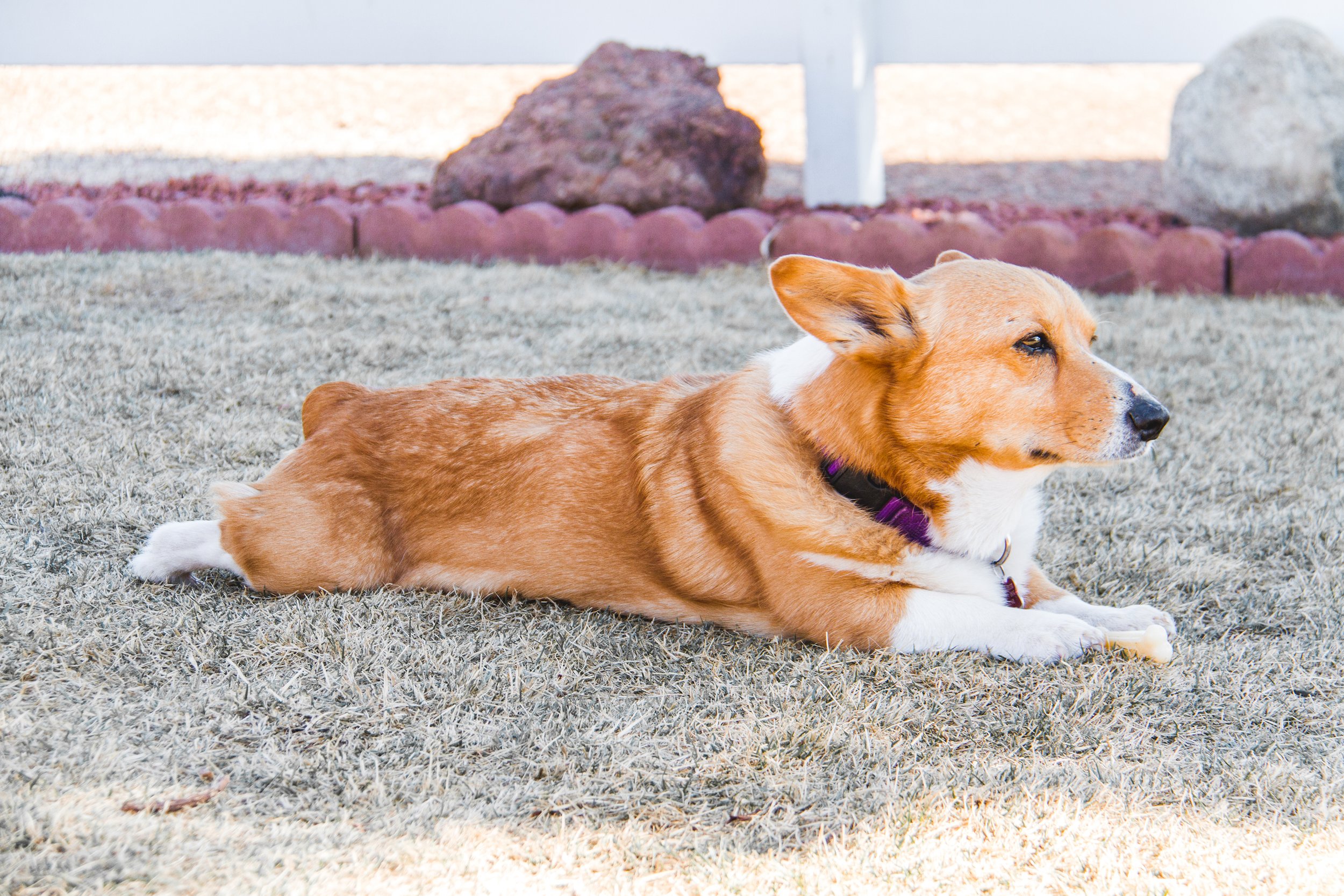
BREED INFORMATION
HISTORY & BREED STANDARDS
Historically it is thought that Corgis are descended from spitz-type dogs introduced into South West Wales by Flemish weavers, who settled there in about 1100 AD. It is also likely that Corgis are closely related to the Swedish Vallhund, perhaps as a result of trading links between the Welsh and the Vikings. The name of the breed probably has it’s origian in the Welsh terms: cor (dwarf) and ci (dog). Early in this century, the two types of Welsh Corgi – the Cardigan and the Pembroke were interbred. This practice stopped when the Kennel Club classified them as separate breeds in 1934. Since then the Pembroke Corgi has become far more popular than the Cardigan, no doubt helped by the fact that the breed is a favorite of Her Majesty the Queen. The Corgi was bred for herding cattle, but today he is mainly kept as a companion and house guard. He is well-suited to the show ring.
The Pembroke Welsh Corgi is a strong, well-built, low set dog of good substance and stamina. He is bold, workmanlike and friendly and should never be nervous or aggressive. Though very popular as a pet dog, he can still be a tough working dog, capable of considerable exercise despite his short legs. His movement is free and active with forelegs reaching well forward without much lift and in unison with the thrusting action of the hind legs. Color is self-coloring in Red, Sable, Fawn or Black and Tan with or without white markings on legs, brisket, and neck. Some white is permissible on the head and foreface.
The head is foxy in appearance and the expression is alert and intelligent. The skull is flat between the ears and fairly wide. The Stop is moderate and the proportion between length of foreface and skull is 3 to 5. The muzzle tapers slightly, the nose being black. The round, medium sized eyes are well set and brown in color, blending well with the color of the coat. The medium sized, pricked ears are slightly rounded. A line drawn from the tip of the nose though the eye should, if extended, pass through, or close to, the tip of the ear. The mouth has strong jaws meeting in the perfect scissor bite.
The neck is fairly long, running into well laid shoulders set at an angle of 90 degrees to the upper arm which is molded around the chest. The lower legs are short and as straight as possible, with ample bone carried right down to the feet. The elbows fit closely to the sides and are neither loose nor tied. The medium length body tapers slightly when it is viewed from above, it is not short coupled. The ribs are well sprung, the chest being broad, deep and well let down between the forelegs.
The topline is level. The hindquarters are strong and flexible with a well angulated stifle. The legs are short with ample bone carried right down to the feet. The hocks are straight when viewed from behind. The oval feet have strong, well arched, tight toes and strong, well arched pads. The two center toes are slightly in advance of the outer two. The nails are short. The tail is short, preferably natural. The coat is of medium length and straight with dense undercoat. it should never be soft, wiry, or wavy.
Height approximately 10-12 inches at the shoulder.
Weight: Dogs 22/26lbs, Bitches 20-24lbs.
TEMPERAMENT
Known as a “big dog in a small package,” corgis have a lot of personality and a great desire to please those they love. As a herding breed, corgis have a tendency to be vocal, making them excellent alarm dogs. They are playful and enjoy spending quality time with their families. It is common for corgis to be shy or cautious with strangers and other dogs, leading to protective and territorial behavior. Early socialization is a necessity for maintaining an even tempered, confident corgi. Corgis are typically good with children, but due to their herding behavior, may nip at their heels during play. The Corgi can be stubborn due to their high intelligence, but with proper training they can be an extremely obedient dog with a large range of commands and tricks at their disposal.
Temperaments can and will range greatly across the breed. Some, as described above, will be “easy”, but others can be more dominant which require strong leadership and a life with clear rules, boundaries, guidance, and structure.
COMMON HEALTH PROBLEMS
Environmental Allergies
Canine Hip Dysplasia
Canine Degenerative Myelopathy
Progressive Retinal Atrophy
Intervertebral Disc Disease
Epilepsy
MORE FOOD FOR THOUGHT
The Corgi mind is highly intelligent and requires engaging activities such as agility, playtime, obedience training, and exercise in order to prevent boredom and ill-behavior. Training is an essential part of corgi ownership. It takes patience and time to teach a corgi, but the rewards far outweigh the effort. Consistent obedience training will ensure a happy, healthy relationship between you and your corgi.
Expect fur! The double-coat of the Corgi sheds year round. With weekly grooming shedding can be greatly reduced.
Many corgis are food motivated and have a tendency to become overweight and obese if you are not careful. Exercise and a proper diet are necessary in order to maintain a healthy weight that will not add stress to their elongated backs. Due not be fooled by their eyes or begging! Canine obesity is the only medical condition is that human-caused.
Finally, always remember that when bringing a new dog into your family, always make sure to spay or neuter.
Not only does spaying and neutering make a happier and healthier dog, it also helps them live longer and stops
the cycle of unnecessary births which ultimately contribute to increased shelter numbers and euthanasia,
and in many counties it is the law.



